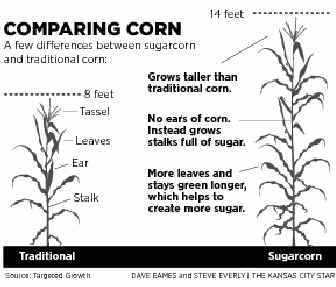The American breadbasket’s amber waves are getting a glimpse of a fledgling new neighbor that’s bred for ethanol and comes with striking similarities to sugarcane. The Brazilian ethanol industry has prospered by relying on ample supplies of sugarcane, which is easier than corn to turn into ethanol. Sugarcane has fueled a successful drive for Brazilian energy independence. But sugarcane, which needs a long, warm growing season, remains little more than a tropical daydream for Midwestern farmers. Now, though, biofuel boosters have something to talk about – “Sugarcorn.”
 |
| Comparison Sugarcorn to Corn |
It’s being developed by Targeted Growth Inc., a Seattle biotechnology company that two years ago was searching for a crop that could be adapted to produce sugar in a way similar to sugarcane but able to grow in the Great Plains. “One thing that jumped out was an opportunity to use corn,” said Donald Panter, senior vice president for crop development at the company. Targeted Growth’s laboratory breakthroughs are being grown in test plots in Illinois and Indiana. More tests next year will be in other Midwestern states – possibly including Kansas and Missouri.
Corn has similarities to sugarcane, such as its sword-shaped leaves. Indeed, Sugarcorn is a takeoff on a type of maize grown in the tropics, which grows traditional ears of corn. Researchers found that when the tropical corn has a longer growing day, such as those in the Midwest, it delays its flowering and sends more energy into making sugar in the stalk instead of producing starch in the corn. Sugarcorn improves the process with genetic surgery.
The result is a corn field that doesn’t produce a single kernel and shoots corn stalks 15 feet high – about twice that of traditional corn. Just like sugarcane, the sugar in Sugarcorn is easily squeezed out to use for ethanol. Proponents said Sugarcorn could be a game-changer for the fledgling Corn Belt biofuels industry because it could double energy output per acre and reduce the energy needed to process the crop to fuel. That’s because the crop’s sugar skips the step where corn’s starch has to be converted into sugar before being fermented and turned into ethanol. If successful, Sugarcorn would make it easier to undercut the cost of conventional gasoline, which is important because ethanol has less energy per gallon than gasoline.
Sugarcorn’s potential will become clearer when it becomes commercially available, which Targeted Growth estimates will be another two years. To be sure, more work remains to be done. Much of that work will focus on increasing sugar yield. Also, field testing is measuring hardiness in Midwest weather conditions. Tests in Indiana and Illinois have been encouraging, prompting ethanol producers to express interest in the feedstock.
Such talks come at a crucial time for the ethanol industry, which recently saw a major producer file for bankruptcy. VeraSun Energy Corp.’s stumble was triggered by corn prices, which briefly topped $8 a bushel in futures trading last summer. It then made a bad bet on locking in those higher prices, fearing that they would rise even more. Corn prices have fallen by roughly half since the summertime peak. The broader industry’s troubles deepened recently when crumbling crude oil prices pushed conventional gas prices lower than ethanol for the first time in nearly two years, cutting deeply into ethanol demand. The global credit crunch also has cast a shadow, prompting many ethanol projects to be canceled.
Source
The Kansas City Star, 2008-12-14.
Supplier
Targeted Growth Inc.
VeraSun Energy
Share
Renewable Carbon News – Daily Newsletter
Subscribe to our daily email newsletter – the world's leading newsletter on renewable materials and chemicals









